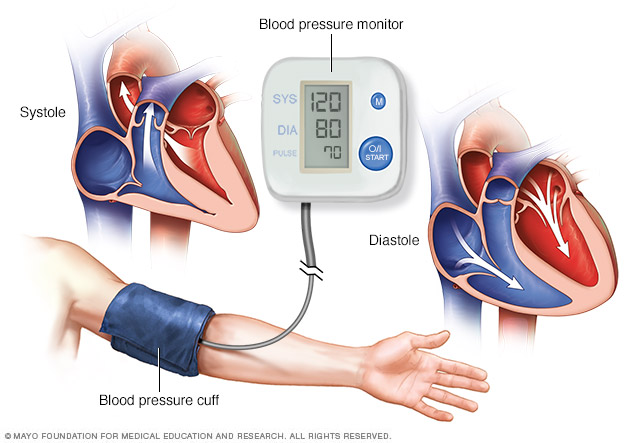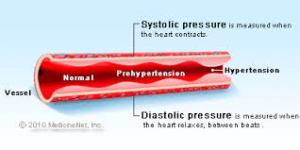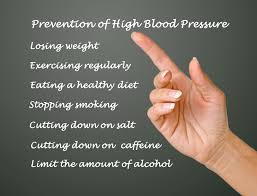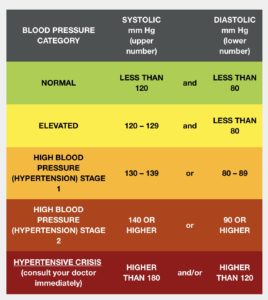High Blood Pressure – what is it?
The most common cause of heart disease is narrowing or blockage of the coronary arteries, the blood vessels that supply blood to the heart itself. This is called coronary artery disease and happens slowly over time. In HIGH Blood Pressure the arteries & veins narrow! Think of a balloons that make animals that mom and dad buy us when at the circus or a fair. Take one of those long thin balloons and if inflated what happens to the balloon if we step on it? Right, due to increase pressure and it will POP! Same concept with HTN; the pressure increases in the vessels due to vessels to narrow or contrict in size (like stepping on the balloon) causing increased pressure in the vessels causing the diagnosis hypertension (HTN). If the high pressure does not get controlled a vessel can pop causing a hemmoragic stroke if it occurs in the brain or the pop of a vessel will cause hemmorage elsewhere if not in the brain. Remember vessels in the brain for the most part are small.
High Blood Pressure or HTN affects 80 million Americans and nearly half of the people in the UK between the ages of 65 and 74, and a large percentage of those between the ages of 35 and 65. One of the problems associated with high blood pressure is that you will probably not even know you have it until you happen to have your blood pressure taken during a routine physical examination.
Upon diagnosis, you may wonder why you never saw it coming. Most people don’t. Only those with severe high blood pressure experience any warning signs at all.
These signs can include headaches, impaired vision, and black-outs.
What B/P actually tells us regarding the numbers!
It is the measurement of the force that blood applies to the walls of the arteries as it flows through them carrying oxygen and nutrients to the body’s vital organs and systems. Naturally, our blood is under pressure as it rushes through our arteries. Even those with blood pressure in the normal range will experience an increase in their blood pressure during rigorous physical activity or during times of stress. It only becomes a problem when the blood continues to run high. This condition of blood pressure is known as hypertension or high blood pressure and in 95% of the cases, the cause of it is never known. However, we do know the factors that set a person up to develop hypertension.
Blood Pressure Readings:
Factors influencing High Blood Pressure
They are as follows:
NON-MODAFIABLE RISK FACTORS ARE 4: HEREDITY-HIGH B/P RUNNING IN THE FAMILY
AGE-THE OLDER, THE HIGHER PROBABILITY YOU WILL END UP WITH B/P DEPENDING ON YOUR HEALTH AND HOW GOOD YOU TAKE CARE OF YOURSELF.
SEX-MALES VS FEMALES
RACE-HIGHIER IN AFROAMERICAN AS OPPOSED TO WHITE.
MODAFIABLE RISK FACTORS=FACTORS YOU CAN CONTROL IN YOUR LIFESPAN:
1-Obesity=Those with a body mass index of 30 or greater.
2-Drinking more than 2 to 4 alcoholic drinks a day.
3-Smoking
4-High cholesterol
5-Diabetes
6-Ongoing Stress/Anxiety
7-Continuous use of excessive salt consumption
Possible causes of High Blood Pressure
Sometimes the cause of a person’s high blood pressure is determined, but this happens in only 5% of the cases. When a cause is found, the person is diagnosed with secondary high blood pressure [hypertension]. In most of these cases, the cause can be linked to an underlying illness such as kidney disease, adrenal gland disease, or narrowing of the aorta. Contraceptive pills, steroids, and some medications can also cause secondary high blood pressure [hypertension], though instances of this are not all that common.
High Blood Pressure and the important numbers:

We hear the numbers, but do we really know what they mean? Since your blood pressure numbers can help you to understand your overall health status, it is important that you keep track of it. By knowing where your numbers are right now, you can head off such serious high blood pressure complications as angina, heart attacks, stroke, kidney damage, and many others that might surprise you – like eye problems and gangrene.
Medical professionals generally provide your blood pressure to you in terms of two numbers – a top one and a bottom one. For example, if your blood pressure is 120/80, they may say that you have a blood pressure of 120 over 80. Here is a definition for these numbers:
The top number– this is your systolic blood pressure. It measures the force of blood in the arteries as your heart beats. The top number means the pressure is reading your heart at work. That is why this number is always highier.
The bottom number – this is your diastolic blood pressure. It is the pressure of your blood when the heart is relaxed in between the times when it is pumping. Means the pressure is reading your heart at rest. That is why the number is always lowest.
Your blood pressure requires monitoring when you have a systolic blood pressure of 140 or over and/or a diastolic blood pressure of 90 or over. Those with diabetes must maintain a lower blood pressure that those who don’t have the condition. Diabetics should maintain a blood pressure of less than 130/80.
Monitors for measuring High Blood Pressure
It is wise to monitor your blood pressure at home in addition to having it taken at your doctor’s office. This will allow you to provide your doctor with readings that have been taken over time, providing a more in depth look at your personal health condition. This will help your doctor to prescribe the right hypertensive medication and treatment for your specific condition. Taking your B/P everyday will help you notice, probably before your visit to the MD, changes in your B/P and especially high blood pressure started which will allow you to get it under control sooner and before it’s a challenge in life changes or before it does worse give you a result that is not reversible (like a stroke or a aortic aneurysm rupture, for example).
The best blood pressure monitors are those that take your measurement from the upper arm. Those that provide readings from the wrist or finger are not as reliable. You’ll also want to make sure that the blood pressure monitor you are considering has been proven in clinical trials. Trusted name brands include those made by Omron, LifeSource, Mark of Fitness, Micro Life, and A and D Instruments. There are other brands available – the important thing is to do your research.


